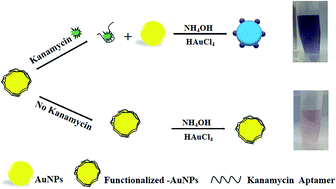UV-visible spectroscopic detection of kanamycin based on target-induced growth of gold nanoparticles
Abstract
A UV-visible spectroscopic detection method of kanamycin was successfully developed based on target-induced growth of gold nanoparticles (AuNPs), using AuNPs as the probe and a kanamycin-specific aptamer as the recognition element. Firstly, the aptamer was incubated with AuNPs, which blocked the surface of the AuNPs, and inhibited the further growth of AuNPs. However, kanamycin bound with the aptamer on the surface of AuNPs with high affinity, competitively desorbed the aptamer and exposed the surface of AuNPs. Then, the growth of AuNPs proceeded by addition of NH2OH and HAuCl4. After the growth of AuNPs, the color and the maximum absorption wavelength of the AuNP solution changed, which was utilized to determine the concentration of kanamycin. Under the optimized conditions, the proposed UV-visible spectroscopic assay showed high sensitivity and high specificity for kanamycin, with a linear detection range from 20 to 100 nM, and the detection limit of 9.21 nM. Moreover, the assay has been successfully applied to detect kanamycin in honey samples without pretreatment. Therefore, it has great application prospects to detect residual kanamycin in food, medicine and water environments.



 Please wait while we load your content...
Please wait while we load your content...